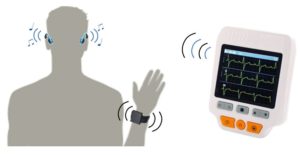Intensive Care Units have an overwhelming number and range of alarms that can distract and/or disturb both patients and physicians. This oversaturation of noise and visual stimulation has lead to the low positive predictive value (≥23%) associated with ICU alarms. Along with simply being distracting in the high stress environment, the high volume and frequency of alarm signals also reduces the ability of the physician to differentiate between patient issues and causes desensitization to the alert stimuli. The current systems in place do not have much flexibility for physicians to track physiological parameters before they reach an alarming threshold, and can cause patients to develop PTSD or panic related psychological issues.
This project aims to address the needs of physicians to track patients’ vital signs before a threshold is met in a manner that is less obtrusive to the patient and care provider while improving positive predictive value of the associated alarms, and the final product will be targeted towards hospitals’ Intensive Care Units.
Model:

The principal components of the system are a bone conduction headset, soundscapes, wearable haptic actuators, and haptic signals. Each physiological parameter and direction (high/low) is associated with a sound, and haptics are incorporated to enhance the distinction between abnormal and concerning pre-alarm zones. The team conducted efficacy studies that trained and tested subjects on multisensory combinations, and the results were analyzed to determine what composition resulted in the highest user accuracy, intuition, and comfort.
The initial phase of the study was designed to determine what combination of sounds was the most pleasant and discernable for subjects to differentiate between vital signs and directions. Three iterations of soundscapes were developed and the optimal one was selected based on which iteration resulted in subjects responding the most quickly and most accurately to changes. The second phase was dedicated to training subjects by introducing discrete or continuous haptics integrated with sounds in order to determine which combination resulted in the fastest response times and the most accurate identification of changes. The third phase was the extinction portion of the study, and tested subjects on each type of multisensory combination to understand how well they were able to retain the training that was introduced in phase 2.
The options for multisensory combinations that were introduced in phase 2 were audio only, audio with discrete haptics, and audio with continuous haptics. Discrete haptics were transmitted as one vibration on the wrist when transitioning from normal (silent, and no haptics) to abnormal and two vibrations from abnormal to concerning in the high direction. In contrast, one vibration was transmitted to the ankle when going from normal to concerning, and two when going from concerning to abnormal in the decreasing direction. The continuous signals were transmitted through the wrist for one variable and through the ankle for the others, and the haptics were determined based on the sound in each zone.
This design was different from previous ones because it introduced the concept of multiple pre-alarm zones, varying haptic signals, and optimizing a soundscape before asking subjects to distinguish between zones.